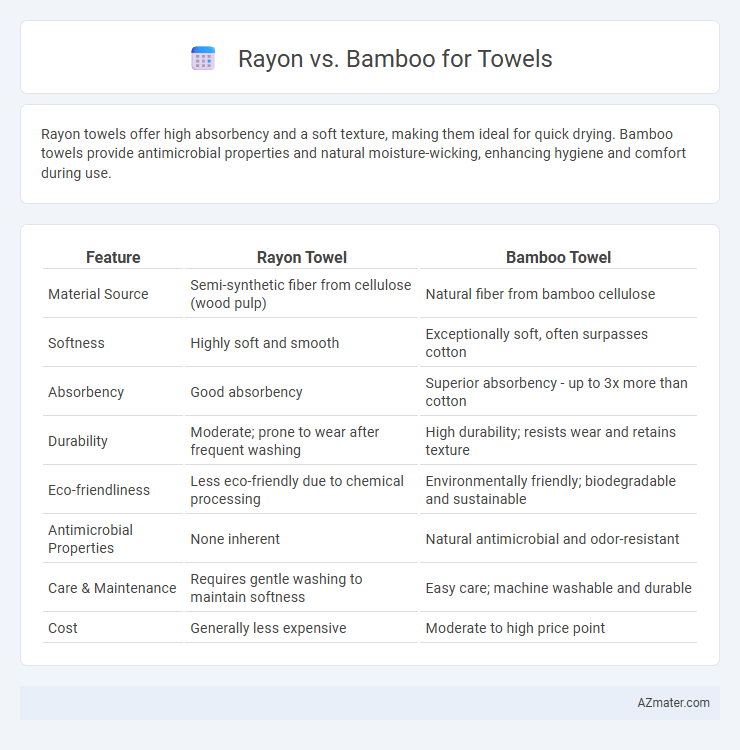Rayon towels offer high absorbency and a soft texture, making them ideal for quick drying. Bamboo towels provide antimicrobial properties and natural moisture-wicking, enhancing hygiene and comfort during use.
Table of Comparison
| Feature | Rayon Towel | Bamboo Towel |
|---|---|---|
| Material Source | Semi-synthetic fiber from cellulose (wood pulp) | Natural fiber from bamboo cellulose |
| Softness | Highly soft and smooth | Exceptionally soft, often surpasses cotton |
| Absorbency | Good absorbency | Superior absorbency - up to 3x more than cotton |
| Durability | Moderate; prone to wear after frequent washing | High durability; resists wear and retains texture |
| Eco-friendliness | Less eco-friendly due to chemical processing | Environmentally friendly; biodegradable and sustainable |
| Antimicrobial Properties | None inherent | Natural antimicrobial and odor-resistant |
| Care & Maintenance | Requires gentle washing to maintain softness | Easy care; machine washable and durable |
| Cost | Generally less expensive | Moderate to high price point |
Introduction to Rayon and Bamboo Towels
Rayon towels are made from regenerated cellulose fibers derived primarily from wood pulp, offering a smooth texture and excellent absorbency that rivals natural fibers. Bamboo towels utilize fibers extracted from bamboo plants through a similar process, providing natural antimicrobial properties and enhanced softness. Both materials serve as eco-friendly alternatives to traditional cotton, appealing to consumers seeking sustainable and comfortable towel options.
What is Rayon?
Rayon is a semi-synthetic fiber made from regenerated cellulose derived from wood pulp, often sourced from bamboo, pine, or eucalyptus trees. It offers a soft texture and high absorbency, making it a popular choice for towels that provide comfort and effective moisture absorption. Compared to bamboo fibers processed mechanically, rayon towels typically have a smoother finish and better durability after repeated washes.
What is Bamboo Fiber?
Bamboo fiber is a natural textile derived from the pulp of bamboo plants, known for its softness, breathability, and antibacterial properties. Unlike rayon, which is a generic term for regenerated cellulose fibers that may be produced from various plant sources, bamboo fiber specifically originates from sustainably harvested bamboo stalks. Towels made from bamboo fiber offer enhanced moisture-wicking ability and hypoallergenic benefits, making them an eco-friendly and comfortable choice for sensitive skin.
Manufacturing Process: Rayon vs Bamboo
Rayon towels are produced through a chemical process where cellulose from wood pulp is treated with chemicals like sodium hydroxide and carbon disulfide to create viscose fibers. Bamboo towels involve converting bamboo cellulose into rayon fibers through a similar viscose method or manufactured mechanically in the case of bamboo linen, but most commercially sold bamboo towels are rayon made from bamboo pulp. The manufacturing process for bamboo towels shares the same environmental concerns as rayon production due to the use of toxic chemicals and energy-intensive steps.
Softness and Comfort Comparison
Bamboo towels exhibit superior softness due to their natural fibers that are moisture-wicking and breathable, providing exceptional comfort and a gentle feel on the skin. Rayon towels, while soft, are typically less breathable and can sometimes feel heavier and less absorbent than bamboo, impacting overall comfort. Bamboo's antimicrobial properties also enhance comfort by reducing odor and bacterial growth, making it a preferred choice for sensitive skin.
Absorbency: Which Towel Performs Better?
Rayon towels, made from regenerated cellulose fibers, typically offer high absorbency due to their fine fiber structure, allowing them to soak up moisture efficiently. Bamboo towels, derived from bamboo pulp, naturally possess antimicrobial properties and excellent absorbency, often outperforming standard rayon in moisture retention. When choosing between rayon and bamboo towels for absorbency, bamboo generally performs better as it combines quick drying with enhanced moisture absorption.
Durability and Longevity
Rayon towels, made from chemically processed cellulose fibers, offer softness but often lack the durability and longevity of bamboo towels. Bamboo towels are naturally strong, resistant to wear and tear, and maintain their integrity through multiple washes due to inherent antimicrobial properties and fiber strength. Choosing bamboo towels ensures a longer-lasting product that withstands frequent use and laundering better than rayon alternatives.
Eco-Friendliness and Sustainability
Rayon towels, made from regenerated cellulose fibers, often involve chemical-intensive processes that challenge their eco-friendliness despite being biodegradable. Bamboo towels, derived from bamboo pulp, offer superior sustainability due to bamboo's rapid growth, minimal water usage, and natural pest resistance, reducing environmental impact. While both fibers provide softness and absorbency, bamboo towels are generally favored for their lower ecological footprint and renewable sourcing.
Price and Value for Money
Rayon towels generally offer a lower price point compared to bamboo towels, making them a budget-friendly option for consumers. Bamboo towels, while often more expensive, provide superior softness, durability, and natural antibacterial properties, enhancing their overall value for money. Investing in bamboo towels ensures long-term benefits in comfort and hygiene, which can justify the higher initial cost.
Which is Better for Your Needs?
Bamboo towels offer superior moisture-wicking and natural antibacterial properties, making them ideal for sensitive skin and eco-friendly preferences. Rayon towels, made from regenerated cellulose fibers, can mimic the softness of cotton but may lack the durability and sustainability benefits of bamboo. For long-lasting, hypoallergenic towels with enhanced absorbency, bamboo is generally the better choice.

Infographic: Rayon vs Bamboo for Towel
 azmater.com
azmater.com